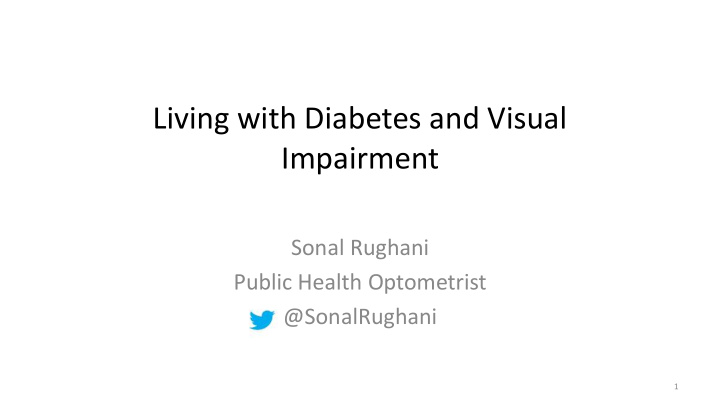



Living with Diabetes and Visual Impairment Sonal Rughani Public Health Optometrist @SonalRughani 1
WHO World Report on Vision • Globally 146 million people living with diabetic retinopathy • Global prevalence of any diabetic retinopathy 34.6% (Yau et al) • Potential to prevent sight loss • Routine eye checks and good diabetes control can protect people’s vision from this condition. • Late detection: poorly integrated eye care services, lack of access, lack of follow up • WHO World Report on Vision Executive Summary https://apps.who.int/iris/bitstream/handle/10665/328721/WHO-NMH-NVI-19.12-eng.pdf 2
Carol’s Story • https://www.youtube.com/watch?v=Nh2W6J0CjD0#action=sh are • Outline challenges of routine daily activities • Medicine adherence • Glycaemic Control • Support, Strategies and Rehabilition 3
Different Types of Vision Loss Loss of Contrast Sensitivity Diabetic Macular Oedema Peripheral Vision Loss Proliferative Diabetic Retinopathy 4
Certificate of Vision Impairment • Irreversible vision loss • Timing • Eye Clinic Liaison Officer • Certification and Registration Process: bridge to rehabilitation and social care support • Tiers of certification: • Sight Impaired (Partially Sighted) • Severely Sight Impaired (Blind) 5
Certificate of Visual Impairment CVI • Registration: with Local Authority as sight impaired (partially sighted) or severely sight impaired (blind) • Access to Support with LA : Daily Living Skills • Bridging Health & Social Care • Financial and welfare benefits • Data Analysis : service provision and service development 6
UK Context • Incidence: 24,000 CVIs each year in England and Wales (Figures for CVIs, Public Health England, 2017) • Prevalence: Around 350,000 people are registered blind or partially sighted in the UK in total. Half of these people are registered blind, and half are registered partially sighted 7
Public Health Indicator for Diabetic Eye Disease 8
Effectiveness of Diabetic Retinopathy Screening • Data from DESP: Wales Retrospective Analysis • New certifications for both sight impairment and severe sight impairment in Wales due to diabetic retinopathy & maculopathy between 2007 and 2015 • 2008-9 to 2014-15: 20.4% reduction • During the same eight-year period: the number of people with diabetes in Wales increased by 52,229 • DR No longer leading cause of visual impairment amongst working age people 9
Modifiable Risk Factors and Prognosis DURATION OF DIABETES • Best predictor of diabetic retinopathy. Diagnosed before the age of 30 years, the incidence of DR after 10 years is 50%, and after 30 years 90% • Diabetic age 20 years 99% of patients with Type I DM and 60% with type II have some degree of diabetic retinopathy. • 5% of Type II diabetics have DR at presentation. POOR GLYCAEMIC CONTROL • Raised HbA1c increased risk of proliferative disease. This is because of increased oxygen- binding capacity of HbA1c leading to hypoxia. • The severity of hyperglycemia • Type I: The Diabetes Control and Complications Trial: intensive control reduced the risk of developing retinopathy by 76% and slowed progression of retinopathy by 54%. • Type II: The UK Prospective Diabetes Study 25% reduction in risk. • Sudden improvement in control may be associated with progression of retinopathy (Chantelau & Kohner). • Type I diabetic patients appear to obtain greater benefit from good control than those with type II. • Target HbA1c level = 6.5-7 %. CARTOID ARTERY OCCLUSIVE DISEASE 10
Modifiable Risk Factors and Prognosis • HYPERTENSION: Appropriate Blood-pressure Control in Diabetes (ABCD) Trial: target BP should be <140/80 • Tight BP control in type II diabetics with maculopathy • NEPHROPATHY • SMOKING: 20 a day triples/quadruples retinopathy • HYPERLIPIDEMIA • ANEMIA: leading to hypoxia • OBESITY 11
Modifiable Risk Factors PREGNANCY • Greater pre-pregnancy severity of retinopathy • Poor pre-pregnancy glycaemic control of diabetes. • Rapid control in early stages of pregnancy. • Development of pre-eclampsia and fluid imbalance 12
Low Vision Assessments • Early Intervention: Sight Loss Journey • Maximise residual vision • Multidisciplinary tailored assessment • Assess impact on mobility, medication management, daily living skills • Rehabilitation • Optical & non-optical aids 13
Bigger Brighter Bolder • Large print (14 point) • Magnification - electronic, hand held • Felt tip pens • Large screens and buttons 14
Bigger: Large Print Correspondence • Accessible Appointment Letters & Clinical Letters • Alternative Formats? 15
Brighter: Task Lighting • Direction of Light • Matt surfaces • Glare • Reduced contrast sensitivity 16
Bolder: Increased Contrast • Use of colour • Use of contrast • Food Packaging 17
Support & Self Advocacy • Local sight loss charity www.visionary.org • RNIB Helpline: 0303 123 9999 www.sightlinedirectory.org.uk • Peer support: rnib connect, connect radio www.rnib.org.uk/connect • Support for people with Learning Disability: www.SeeAbility.org • Guide Dogs : my guide: navigation/befriending www.guidedogs.org.uk 18
Call to Action • Collaboration • Referral • Patient Education • Power of Prevention • Management of risk factors • Timely treatment 19
Questions 20
Support & Self Advocacy • Local sight loss charity www.visionary.org • RNIB Helpline: 0303 123 9999 www.sightlinedirectory.org.uk • Peer support: rnib connect, connect radio www.rnib.org.uk/connect • Support for people with Learning Disability: www.SeeAbility.org • Guide Dogs : my guide: navigation/befriending www.guidedogs.org.uk 21
Recommend
More recommend